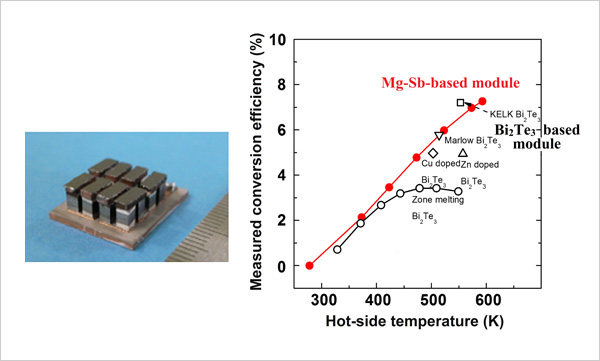 Press Release 2021
Press Release 2021
Development of a Novel Thermoelectric Material with Conversion Efficiency as High as Bi2Te3
—High-Performance Module Containing Only Small Amounts of Scarce Elements Can Be Useful in Converting Waste Heat into Electricity—
National Institute of Advanced Industrial Science and Technology (AIST)
Japan Science and Technology Agency (JST)
NIMS has succeeded in enhancing the thermoelectric performance of an n-type Mg3Sb2-based material by minutely doping with copper. NIMS and AIST then constructed a module by combining this material with a high-performance p-type material, achieving a conversion efficiency of 7.3% between room temperature and 320℃.
“Demonstration of Ultrahigh Thermoelectric Efficiency of ~7.3% in Mg3Sb2/MgAgSb Module for Low Temperature Energy Harvesting”
Zihang Liu(NIMS), Naoki Sato (NIMS), Weihong Gao(NIMS), Kunio Yubuta (Tohoku University), Naoyuki Kawamoto (NIMS), Masanori Mitome (NIMS), Keiji Kurashima (NIMS),Yuka Owada (NIMS), Kazuo Nagase (AIST), Chul-Ho Lee (AIST), Jangho Yi (NIMS), Koichi Tsuchiya (NIMS), and Takao Mori(NIMS);
Journal:Joule [April 16, 2021];
DOI : 10.1016/j.joule.2021.03.017)

Figure. Newly developed module comprised of an Mg3Sb2-based material (left). Its thermoelectric conversion efficiency indicated by the red circles (right).
Abstract
A large proportion of the energy used by humans is dissipated as waste heat. Approximately 90% of this is in the low-temperature range below 320°C. Intensive global efforts are underway to develop thermoelectric materials capable of converting low-temperature waste heat into electricity. Achieving highly efficient thermoelectric conversion requires materials that are simultaneously low in thermal conductivity and high in electrical conductivity. However, developing such materials has been extremely challenging as these two types of conductivity are interrelated. For this reason, Bi2Te3-based materials have reigned as the most efficient in converting low-temperature heat into electricity for over half a century. Because Bi2Te3-based materials contain scarce tellurium as their main component, their practical use in thermoelectric conversion has been very limited. It is therefore highly desirable to develop high-performance thermoelectric materials containing significantly less tellurium.
This research group discovered that the thermoelectric performance of an Mg3Sb2-based material can be enhanced by doping it with a small amount of copper atoms. The enhanced performance was found to occur through two separate mechanisms. First, minute amounts of copper atoms indicated to enter interstitial sites radically scatter phonons—thermal energy carriers—substantially reducing thermal conductivity. Consequently, heat dissipation was greatly reduced, increasing thermoelectric conversion efficiency. Second, copper atoms entering grain boundaries effectively reduced the scattering of electrons. As a result, the electrical mobility of the polycrystalline material—normally not as good electrical conductors—increased to a level equivalent to the electrical mobility of single-crystalline materials. The increased electrical conductivity reduced energy loss caused by Joule heating. These two mechanisms simultaneously reduced the thermal conductivity and increased the electrical conductivity of the Mg3Sb2-based material, thereby increasing its thermoelectric conversion efficiency.
Our results may promote practical and widespread use of thermoelectric modules containing only small amounts of scarce elements to recover waste heat, leading to significant energy conservation. In addition, such modules may be used to develop stand-alone power sources for various types of sensors, which will be needed in very large quantities to realise Japan’s Society 5.0 vision. Finally, new ways of altering phonon scattering behavior and controlling grain boundaries were discovered in this project which may be applicable to enhancing the performance of a wide range of other thermoelectric materials.
This project was carried out by a research group led by Takao Mori (Leader of the Thermal Energy Materials Group, International Center for Materials Nanoarchitectonics, NIMS) and Chul-Ho Lee (Prime Senior Researcher, Research Institute for Energy Conservation, AIST).
This work was conducted in conjunction with a project entitled “Innovative thermoelectric conversion technologies for stand-alone power supplies for sensors” (project leader: Takao Mori) funded by the JST-Mirai Program.
This research was published in the online version of Joule at 11:00 am on April 16, 2021, EST (12:00 am on April 17, Japan Time).
(Regarding this research)
Takao Mori
Group Learder,
Thermal Energy Materials Group,, MANA, NIMS
Tel:+81-29-860-4323
E-Mail:MORI.Takao=nims.go.jp=nims.go.jp
(Please change "=" to "@")
(General information)
Public Relations Office
National Institute for Materials Science
Tel:+81-29-859-2026
Fax:+81-29-859-2017
E-Mail:pressrelease=ml.nims.go.jp
(Please change "=" to "@")
Media Relations Office
Public Relations Department
National Institute of Advanced Industrial Science and Technology (AIST)
Tel:+81-29-862-6216
Fax:+81-29-862-6212
E-Mail:hodo-ml=aist.go.jp
(Please change "=" to "@")
Public Relations Division
Japan Science and Technology Agency (JST)
Tel:+81-3-5214-8404
Fax:+81-3-5214-8432
E-Mail: jstkoho=jst.go.jp
(Please change "=" to "@")

